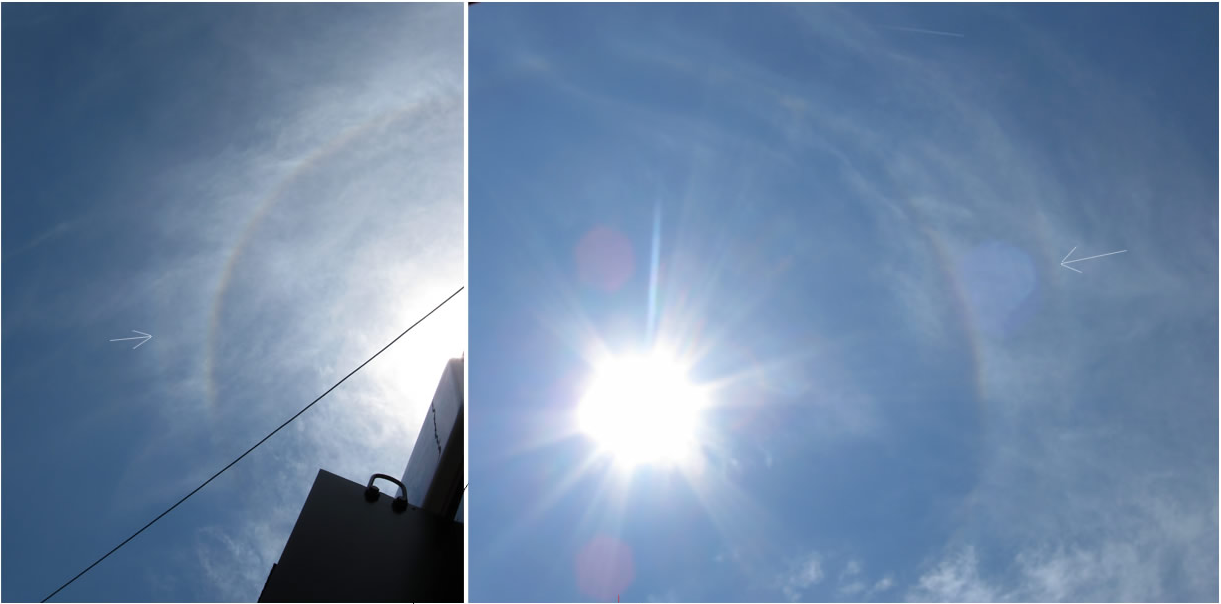OPOD - Parry Arcs at High Sun
OPOD - Parry Arcs at High Sun
Have you ever witnessed a mesmerizing atmospheric optical phenomenon known as the Parry arc? This rare occurrence can be seen when cirrus clouds thicken around noon, creating the perfect conditions for the display to appear. On May 25, '11, in Jacksonville, Florida, Nick Beck had the extraordinary opportunity to observe and capture this captivating sight. He noticed not only the 22-degree halo and weak circumhorizon arc but also an additional arc outside of it. This secondary arc, known as the lower suncave Parry arc, is exceptionally rare and made the sighting even more remarkable.
The Parry arc is named after its discoverer, William Edward Parry, who first described it during his Arctic expeditions in the early 19th century. It is an arrow-shaped arc that can be seen in the sky, usually appearing below the 22-degree halo or circumscribed halo. The inner colored arc in the images captured by Nick Beck represents the circumscribed halo caused by singly oriented column crystals. To simulate this atmospheric phenomenon, HaloSim ray tracing software was used, employing rather long column crystals with a c/a ratio of 10 to weaken the parhelic circle.
In the case of the lower suncave Parry arc observed by Nick Beck, its ray path is .4,6., indicating that it enters the crystal face numbers .4 and .6. On the other hand, the upper Parry ray enters the top face of the crystal, specifically face numbers .3 and .5. It's important to note that well-oriented crystals are necessary to perceive this rare arc in nature.
As the solar altitude changes, the appearance of Parry arcs, along with other atmospheric optical phenomena, also varies. For instance, the lower Parry arc has a greater radius than the circumscribed halo when the sun is at a 90-degree angle. This discrepancy occurs because the Parry rays cannot enter the crystal at the minimum deviation angle.
Interestingly, the sighting captured by Nick Beck also revealed an infralateral arc and parhelic circle, which emerged after the Parry arcs disappeared. The parhelic circle observed was particularly small in size. These additional optical phenomena added an extra layer of enchantment to an already extraordinary display.
In conclusion, witnessing a Parry arc at high sun is an extremely rare occurrence. It requires specific atmospheric conditions, such as cirrus clouds and the presence of well-oriented column crystals. The lower suncave Parry arc, in particular, is a remarkable sight to behold. Observing these atmospheric optics phenomena provides a glimpse into the wonders of our natural world and reminds us of the intricate beauty that surrounds us.

High Sun Lower Suncave Parry Arc
A very rare sighting by Nick Beck at Jacksonville, Florida May 25, '11. ©Nick Beck, shown with permission.
�There were cirrus clouds thickening around noon, and a 22 degree halo (or circumscribed halo) and weak circumhorizon arc showed up. At 1:45, the sun was 79° high and I noticed not only the 22° halo (or a circumscribed halo, to be more accurate because when it became more complete, it was sharply defined and slightly elliptical), but another arc outside of it! When the display became more complete, I noticed the arc also extending from the bottom also. Immediately I knew it was a lower suncave arc, which I knew were very rare. Later, the Parry arcs went away, but an infralateral arc and parhelic circle showed up. The parhelic circle was very small too.�
The Parry arc is arrowed in the two images. The inner coloured arc is a circumscribed halo from singly oriented column crystals. The display is simulated in the HaloSim ray tracing at right. Rather long column crystals c/a=10 were used to weaken the parhelic circle which cannot be discerned in the images at that time.
The lower suncave Parry arc is 'lower' because its ray path is .4,6.- see crystal face numbers. The upper Parry ray enters the top face of the crystal .3,5.. The weak arc in the simulation between the circumscribed and infralateral arc is another Parry arc, this time with an internal reflection within the crystal .4,5,6.. Well oriented crystals would be required to see it in nature.
Change in appearance of Parry (and other)
arcs with solar altitude.
LP - Lower Parry .4,6.
UP - Upper Parry .3,5.
CA - Circumscribed arc
TA - Tangent arc
PC - Parhelic circle
That the lower Parry has a greater radius than the circumscribed halo at 90° sun arises because the Parry rays cannot enter the crystal at the minimum deviation angle.
Note: this article has been automatically converted from the old site and may not appear as intended. You can find the original article here.
Reference Atmospheric Optics
If you use any of the definitions, information, or data presented on Atmospheric Optics, please copy the link or reference below to properly credit us as the reference source. Thank you!
-
<a href="https://atoptics.co.uk/blog/opod-parry-arcs-at-high-sun/">OPOD - Parry Arcs at High Sun</a>
-
"OPOD - Parry Arcs at High Sun". Atmospheric Optics. Accessed on July 27, 2024. https://atoptics.co.uk/blog/opod-parry-arcs-at-high-sun/.
-
"OPOD - Parry Arcs at High Sun". Atmospheric Optics, https://atoptics.co.uk/blog/opod-parry-arcs-at-high-sun/. Accessed 27 July, 2024
-
OPOD - Parry Arcs at High Sun. Atmospheric Optics. Retrieved from https://atoptics.co.uk/blog/opod-parry-arcs-at-high-sun/.